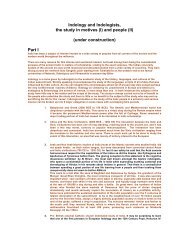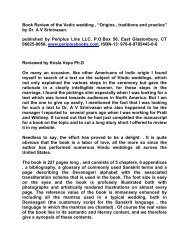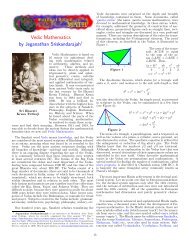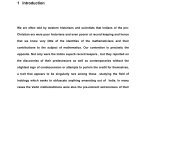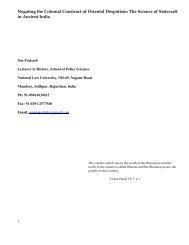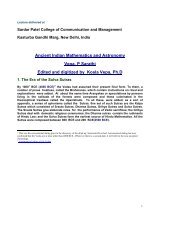The Dhaarmik Traditions - Indic Studies Foundation
The Dhaarmik Traditions - Indic Studies Foundation
The Dhaarmik Traditions - Indic Studies Foundation
You also want an ePaper? Increase the reach of your titles
YUMPU automatically turns print PDFs into web optimized ePapers that Google loves.
23. Surprisingly, although it is language that primarily connects all the IE peoples,<br />
linguistic evidence on its own is completely inadequate in determining absolute<br />
dates (Kazanas 1999: 17-8); one must resort to archaeological and cultural<br />
evidence. I have seriously changed my mind on this subject; I have no axe to<br />
grind, as it were, no position or reputation to maintain; I can and shall change my<br />
mind again if strong and sufficient evidence emerges. Prof Witzel raises many<br />
points for discussion some useful, some wasteful but offers no evidence other<br />
than conjecture. Conjecture or hypothesis is not admissible as evidence in any<br />
impartial Court of Law. (Nicholas Kazanas, <strong>The</strong> Date of the Rig veda, 2001)<br />
24. <strong>The</strong> Harappans were obviously a literate and highly civilized people who<br />
maintained their 1000 year old culture with peaceful means through trade and<br />
perhaps religion rather than conquest and expansion. <strong>The</strong> area they inhabited<br />
was, according to Rao (1991: 1), ³1.5 million square kilometers² though I suspect it<br />
was much bigger. <strong>The</strong>n at about 2000 down to 1800, because of ecological and<br />
environmental changes including the alteration of the routes of some rivers and as<br />
a result, the desiccation of the SarasvatI river, they, or many of them, began to<br />
move eastwards to the Gangetic basin while their culture was breaking down. At<br />
about this time, then, enter our illiterate barbarians, the Aryans. Here the Allchins<br />
(Parpola and Witzel) fail to notice the glaring contradiction in their theory: if the<br />
Aryans had acquired the ³material culture and lifestyle² of the Harappans before<br />
they entered into Saptasindhu, then the RV hymns ought to reflect Harappan<br />
elements (urbanization, fixed fire-hearths, bricks, silver, cotton, rice); but it is the<br />
later texts (BrAhmaNas and sUtras) that do so, and not at all the RV hymns.<br />
Anyway, the Aryans take over and after 2 or 3 centuries produce a most<br />
astonishing collection of hymns, to be followed by other collections, various prose<br />
works about cultic rites and codes of social behaviour. Lord Renfrew (ignoring the<br />
archaeological evidence he cites) suggests they came as mounted bands and<br />
formed an élite (1989: 197) presumably with their horses alone since in all else<br />
they were just like the natives. All that the natives left were their ruined brick-built<br />
cities and some seals with inscriptions the nature and use of which is still<br />
unknown. In this Region of the Seven Rivers, then, we have an archaeologically<br />
well attested culture that seems to have no literature at all (other than the briefest<br />
inscriptions) no code of laws, no religious hymns or secular songs, no fables and<br />
tales, and then an illiterate people that is not archaeologically attested yet<br />
produces, in quick succession, all the kinds of literature that the previous culture<br />
lacked. It is a most amazing paradox, an astonishing coincidence of space, time<br />
and people. All this is, of course, possible just as it is possible to be struck by<br />
lightning in one¹s bed, or to fall from the 10th floor on the lawn below and live with<br />
only a few concussions. Many wondrous things are possible in life, but the<br />
question is do they really happen<br />
96



